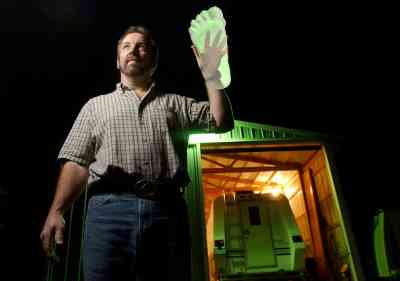Do Bigfoot Hear Cameras?
Posted by: Loren Coleman on November 25th, 2008
Can Bigfoot “sense” human activity through the electronic items that humans bring into the interactions? Can Sasquatch “hear” cameras? Is what is being learned about this leading to findings that may impact the search for evidence of Bigfoot?



Above William Dranginis monitors his motion-detection camera and demonstrates his EyeGotcha invention. (Photographs by Darrow Montgomery.)
Guest blogger William M. Dranginis, a well-known hominological investigator of Manassas, Virginia, looks at the issues:
I would like to answer some questions that have been raised concerning cameras and if they make high pitched sounds that humans cannot hear. The simple answer is YES!
Many types of electronics devices such as surveillance cameras, tape recorders, camcorders as well as other kinds of electronics produce measurable sound in the ultrasonic range. The ultrasonic sounds are produced at the electronic component/circuit board level. Even small electrical components soldered to a circuit board can transmit their ultrasonic vibrations through to the circuit board they are mounted to causing the circuit board to vibrate and produce ultrasonic sounds. I have demonstrated this process at Eric Altman’s East Coast Bigfoot Conference as well as Don Keating’s Ohio Conference.
I have been working on this concept since I saw a deer looking into one of my remotely deployed video cameras back in 1997. The deer in question tripped the surveillance system and it started to record the black and white video as well as audio. The recording showed the deer looking directly at the camera from about 15 feet away, during this time the deer kept twitching its ears and it was obvious the deer was hearing something produced by the camera.
Soon after reviewing the video footage, I conducted a search on deer hearing. I found that deer can hear into the ultrasonic range as well as many other animals. After that, I searched, found and purchased a device that can detect ultrasonic sound and convert that sound into audio we humans can hear and record. The camera used in that particular surveillance system was tested and it did in fact produce ultrasonic sounds I was able to measure and document. The sounds you hear are high pitched and mixed with various tones, similar to the sound of bees around a bee hive.
As some people have stated, they can hear high pitched sounds in some electronic equipment, this is not uncommon.
So yes, some electronic equipment produces high pitched ultrasonic sound we can measure and document.
Can the Bigfoot creatures hear these sounds? I don’t think anyone can answer that question right now.
Hopefully, the new EyeGotcha camera systems I am building will not produce ultrasonic sounds and catch these creatures off guard. The camera systems will be going on sale in the spring, starting a manufacturing business of this magnitude takes time and money, but it’s almost ready to go.


Personally, I find this man’s dedication to looking beyond the ordinary to be very helpful to the field. I would like to send out my thanks to Bill Dranginis, once again, for his donation of unbreakable, kid-friendly, nearly transparent two-part clear urethane display casts of the footprints of Bigfoot, Yeti and Orang Pendek, to the International Cryptozoology Museum. It has been great working with Bill on this educational project of cast exchanges. Dranginis’s specially designed casts are a great resource invention, and I wish him well with the rollout of his EyeGotcha camera systems.
^^^^^^^^^^^^^^^^^^^^^^^^^^^^^^^^^^^^^^^^^^^^^^^^^^^^

Help move the museum to a more separate, more open space! Please remember to donate to the museum for Thanksgiving, and today you may directly send a check, money order, or, if outside the USA, an international postal money order made out “International Cryptozoology Museum” to
International Cryptozoology Museum
c/o Loren Coleman
PO Box 360
Portland, ME 04112
Easy-to-use donation buttons are now available here or merely by clicking the blank button below, which takes you to a donation site without you having to be a member of PayPal. Thank you, everyone!
You may also merely use PayPal to [email protected]
About Loren Coleman
Loren Coleman is one of the world’s leading cryptozoologists, some say “the” leading living cryptozoologist. Certainly, he is acknowledged as the current living American researcher and writer who has most popularized cryptozoology in the late 20th and early 21st centuries.
Starting his fieldwork and investigations in 1960, after traveling and trekking extensively in pursuit of cryptozoological mysteries, Coleman began writing to share his experiences in 1969. An honorary member of Ivan T. Sanderson’s Society for the Investigation of the Unexplained in the 1970s, Coleman has been bestowed with similar honorary memberships of the North Idaho College Cryptozoology Club in 1983, and in subsequent years, that of the British Columbia Scientific Cryptozoology Club, CryptoSafari International, and other international organizations. He was also a Life Member and Benefactor of the International Society of Cryptozoology (now-defunct).
Loren Coleman’s daily blog, as a member of the Cryptomundo Team, served as an ongoing avenue of communication for the ever-growing body of cryptozoo news from 2005 through 2013. He returned as an infrequent contributor beginning Halloween week of 2015.
Coleman is the founder in 2003, and current director of the International Cryptozoology Museum in Portland, Maine.










There’s nothing radical about the idea that many mammals hear sounds above or below the range of human hearing, or that animals may be startled or annoyed by low-volume sounds a human would consider inconsequential. (I think my dog could pick up the sound of a can opener from the space shuttle.)
It’s logical that trailcams, etc. should be as quiet as we can make them, at all frequencies. I do wonder, though, if there is any case where a known species cannot be photographed due to camera noise as opposed to other factors like rarity, shying away from human scent, etc.
I have no doubt most animals hear these sounds. I was born in 1960 and all my life I’ve had to avoid appliance stores (where they sell TVs and such) because of the noise. I did notice in the late 90’s that the sounds had died down somewhat. My point is, IF the BF hears the camera, it isn’t that s/he knows it is a camera and hides, it just hurts his/her ears! LOL
I hope this new invention helps! I’d love to see the photo evidence of BF.
thanks for keeping us updated!
I think that, as with other animals, the sasquatch’s reaction to things such as camera noise will vary by individual. Given that it appears to be a higher primate, I’d expect to see greater individual variability, with a lot of factors coming into play.
There’s no one way they will all react; work with known animals shows this.
I wouldn’t waste too much time on this. I personally think that conventional trail cams will work – if the target happens to go to the right spot and trips the mechanism. Some individuals might avoid a camera. Experience with known animals seems to indicate that many, if not most, won’t.
“I do wonder, though, if there is any case where a known species cannot be photographed due to camera noise as opposed to other factors like rarity, shying away from human scent, etc.”
Good question Matt!
Does the motion detector emit a sound? I can understand the camera emitting sound when it turns on, but like the deer mentioned above. When the camera noise starts the animal has already triggered the motion detector and is standing in camera range when the camera activates.
The high frequency noise emmitted by the trail cams doesn’t scare away animals we know can detect high frequency sounds, deer, coyotes, foxes, bob cats, etc.
This theory that Sasquath can avoid trail cams by hearing the motion detector is an amazing leap to explain the lack of clear pictures. For me it takes more faith to believe it than to believe in the big guy himself.
This along with the the recent ‘fingerprint’ post were really good! Thanks.
I wanted to say that recently I was just kind of thinking about how animals perceive humans and then it hit me. I think one of the reasons that we are so intimidating is because animals can sense are high level of intelligence and I think that ‘weirds them out’ and can be intimidating.
The same way when people have spoken about Sasquatch encounters, and they ‘feel’ there level of intelligence (by looking into there eyes for instance), which may be a bit eerie…
I think the Sasquatches may feel even more intelligence being emitted from us.
Good morning Cryptos…
All reasonable comments regarding “Squatch” and camera sounds…especially if “Squatch” is just a big monkey. There was nothing apelike in either of my two daylight road crossings.
The Native American folklore of many First Nations teaches…Sasquatch are a “primitive tribe” or an “ancient peoples”…it seems foolish to ignore the history of thousands of years of co-existence…peaceful or otherwise…JMHO
Happy Holidays…gobble gobble…
live and let live…
ole bub and the dawgs
I agree with Matt Bille, it may be the human scent ON the camera’s themselves.
A very good post by Loren, Bill and the commentators.
I still maintain that based upon the reported close encounters of of human and Sasquatch that the species is somewhat telepathic. The ability to sense the other species or their intentions can explain to a great degree the variance in reported encounter reactions for both humans and BF. The reactions range from extreme fear (which I felt on my first encounter) to mild curiosity.
Bill has been working on the camera angle for a long time and if he’s right we’ll get a decent picture of a specimen within a year or two after he introduces the camera. It’s quite possible the specimens spot a majority of the game cameras for being out of place or detect human scent and become cautious.
Also, the proliferation of high speed digital cameras will increase the chance of getting a really good photo of a specimen.
One of the things to remember though about a really good photo is that it won’t convince science of the existence of the species. However, it might convince science that the Bigfoot mystery deserves scientific investigation and shouldn’t be relegated to myth or legend. This will depend upon the quality of the picture and who took it and where.
Good luck with the camera Bill and please keep us posted. My best.
I don’t think a sasquatch avoids trail cams for the human scent. If this were the case, there would not be any sasquatch encounters at all, meaning a human reaks more of human scent than would a trail cam handled by a human.
Anyone ever “hear” a TV when the volume is all the way down? That high pitched “EEEEEEEEEEEEEEE” sound. A similar high pitched sound is currently used as a ringtone for cellular phones, popular with teenagers in high school because the sound is inaudible to adults over 40 years old (teachers). I’m inclined to believe that a sasquatch type creature can hear or sense the electromagnetic field in electronic equipment, especially in areas where like in the deep woods where there is little EM pollution.
I think that animals that are sufficiently intelligent might well enough notice that there is a trail cam now when there wasn’t one before. An omivore that might just be able to climb, or at least pull down branches, isn’t only going to look at eye-level, it is going to look along the ground and up in the branches above. Anything out of the ordinary is going to be noticed and might spook the animal. I just saw a show on PBS about Seton’s hunt for the alpha male wolf Lobo in the SouthWest nearly a century ago. No matter how well they hid the traps and avoided scent, Lobo could tell that something had changed from before, and avoided the traps, or even dug them up. If there are Napes, surely they are at least as intelligent and possibly as observant as wolves.
And the motors running in camcorders do make a noise. An old-fashioned all-mechanical Pentax K-1000 film camera wouldn’t and if that family that has ‘contact’ with a family of Napes really does, they could use such a camera.
Hugh compliments to Mr Dranginis for his work -so far-and perhaps he’s the ONE ! To comfirm the Gimlin and Patterson film etc etc etc……..
I always had a vague idea that Sass could see the camera beam and which put himer off. But this sound idea seems a lot better and is researched, thats what caps it! What this raises is the qustion why should Sass be bothered about it? Is it experience with shocks from electric fencing where the transformer gives off a buzz ? I expect older sasquatches would have bumped into it at some time and passed the message down or is there a natural phenomenom which Sass finds unpleasant or threating ? Is there another unatural phenominom which has the same effect?
From my own experience, i’m sure shared, walking round a familiar but generally unused wilderness and being alert, any signs of human intrusion can be very distinctive. Even missing out on subtle, to us, smells. Then when cameras are placed I expect in Sass terms there is a bit of a commotion! Very promising but will Saquatch, true to form, still evade us all?
I don’t think that they can hear a camera hum better than we do. I do think that they’re just not stupid.
Sometimes I hear a buzzing noise like what was described. I guess this means I’m hearing into the ultrasonic range. That’s weird.
I agree with coelacanth1938. I think this story illustrates well, our tendencies to over-complicate things.
I think that a quieter camera system is well worth exploring as well as the system having the ability to remain out in the field for long periods of time.
Coming from a man who has spent countless hours in the field over many years using a wide array of visual and audio recording equipment, Mr. Dranginis’ ideas are not just mere thinking outside the box alone and I believe they are deserving of some attention.
I have held off buying a game cam once I heard about his ‘eyegotcha’ system concept, I just hope that I will be able to afford one.
I also agree with Airforce47. It is likely that intelligent animals, and even smaller animals, can sense intelligence. All animals, when they think, wether subconsciencely or otherwise, emit brain waves that other creatures can “pick up” or sense without noticing. they may feel terror or couriousity towards us depending on our intentions, and same with us, on a slightly lesser scale. I believe this can also explain the times when nothing seeems out of the ordinary, but you suddenly have feelings of overwhelming fear , or suddenly feeling that sticking around wherever you are is a very bad idea, though theres no sign of anything wrong.